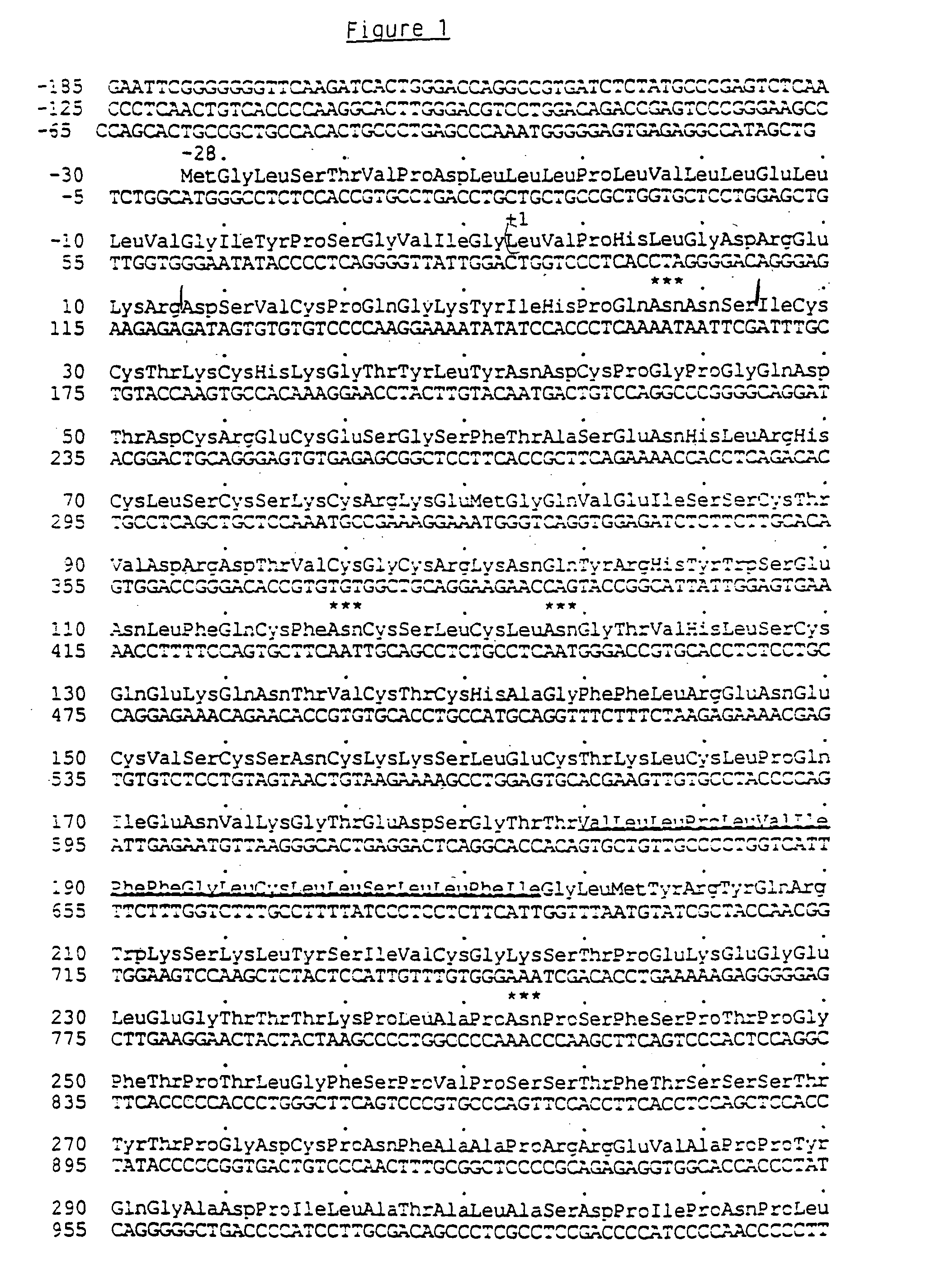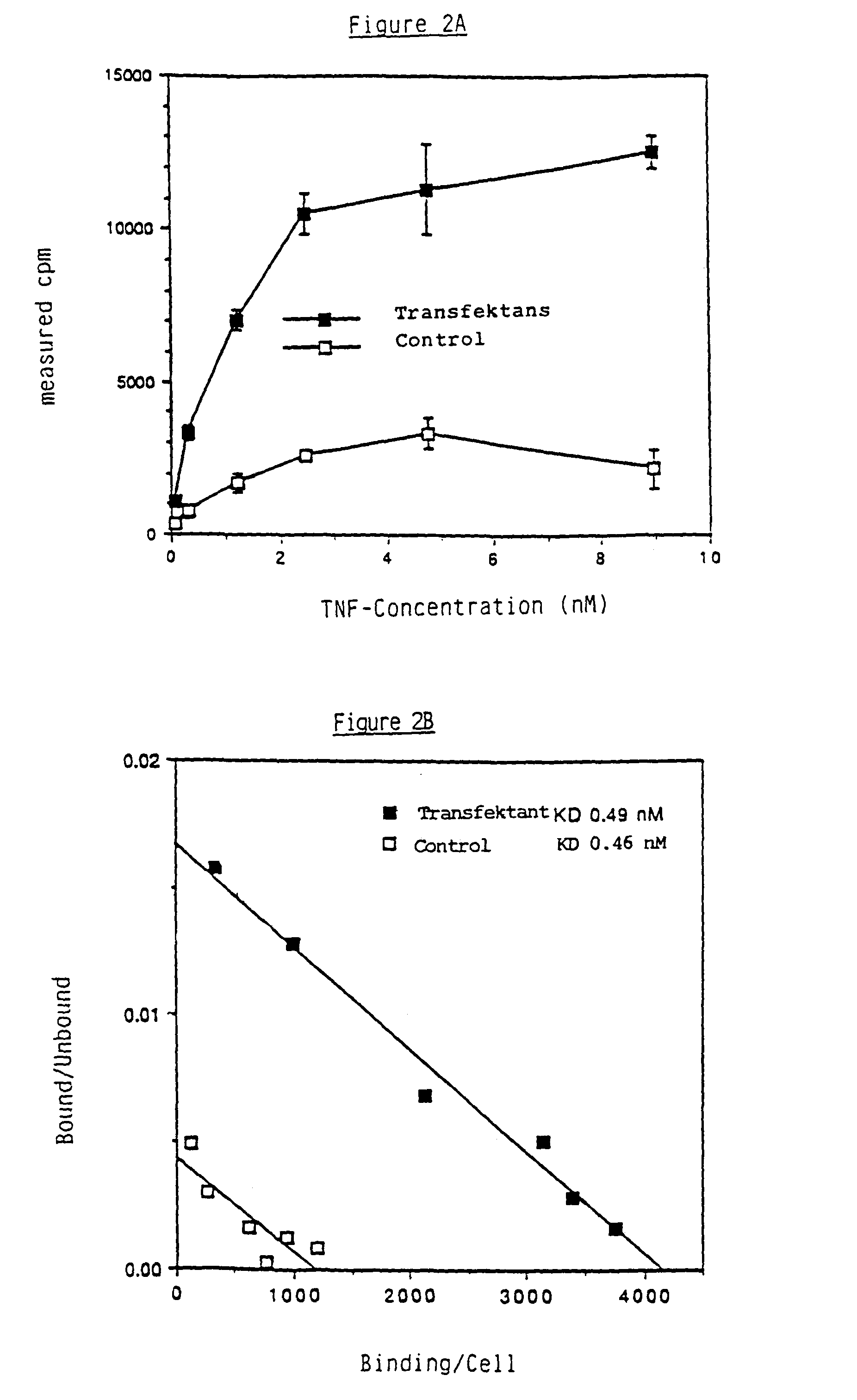Human TNF receptor fusion protein
a technology of fusion protein and tnf receptor, which is applied in the direction of virus, peptide/protein ingredient, depsipeptide, etc., can solve problems such as inability to meet the needs of human tnf receptors
- Summary
- Abstract
- Description
- Claims
- Application Information
AI Technical Summary
Problems solved by technology
Method used
Image
Examples
example 1
Detection of TNF-Binding Proteins
[0061]The TNF-BP were detected in a filter test with human radioiodinated 125I-TNF. TNF (46, 47) was radioactively labelled with Na125I (IMS40, Amersham, Amersham, England) and iodo gene (#28600, Pierce Eurochemie, Oud-Beijerland, Netherlands) according to Fraker and Speck [48]. For the detection of the TNF-BP, isolated membranes of the cells or their solubilized, enriched and purified fractions were applied to moist nitrocellulose filter (0.45μ, BioRad, Richmond, Calif., USA). The filters were then blocked in buffer solution with 1% skimmed milk powder and subsequently incubated with 5·105 cpm / ml of 125I-TNFα (0.3-1.0·108 cpm / μg) in two batches with and without the addition of 5 μg / ml of non-labelled TNFα, washed and dried in the air. The bound radio-activity was detected semiquantitatively by autoradiography or counted in a gamma-counter. The specific 125I-TNF-α binding was determined after correction for unspecific binding in the presence of unlab...
example 2
Cell Extracts of HL-60 Cells
[0062]HL60 cells [ATCC No. CCL 240] were cultivated on an experimental laboratory scale in a RPMI 1640 medium [GIBCO catalogue No. 074-01800], which contained 2 g / l NaHCO3 and 5% foetal calf serum, in a 5% CO2 atmosphere, and subsequently centrifuged.
[0063]The following procedure was used to produce high cell densities on an industrial scale. The cultivation was carried out in a 75 l Airlift fermenter (Fa. Chemap, Switzerland) with a working volume of 58 l. For this there was used the cassette membrane system “PROSTAK” (Millipore, Switzerland) with a membrane surface of 0.32 m2(1 cassette) integrated into the external circulation circuit. The culture medium (see Table 1) was pumped around with a Watson-Marlow pump, Type 603U, with 5 l / min. After a steam sterilization of the installation, whereby the “PROSTAK” system was sterilized separately in autoclaves, the fermentation was started with growing HL-60 cells from a 20 l Airlift fermenter (Chemap). The ce...
example 3
Production of Monoclonal (TNF-BP) Antibodies
[0066]A centrifugation supernatant from the cultivation of HL60 cells on an experimental laboratory scale, obtained according to Example 2, was diluted with PBS in the ratio 1:10. The diluted supernatant was applied at 4° C. (flow rate: 0.2 ml / min.) to a column which contained 2 ml of Affigel 10 (Bio Rad Catalogue No. 153-6099) to which had been coupled 20 mg of recombinant human TNF-α [Pennica, D. et al. (1984) Nature 312, 724; Shirai, T. et al. (1985) Nature 313, 803; Wang, A. M. et al. (1985) Science 228, 149] according to the recommendations of the manufacturer. The column was washed at 4° C. and a throughflow rate of 1 ml / min firstly with 20 ml of PBS which contained 0.1% Triton X 114 and thereafter with 20 ml of PBS. Thus-1-enriched TNF-BP was eluted at 22° C. and a flow rate of 2 ml / min with 4 ml of 100 mM glycine, pH 2.8, 0.1% decyl-maltoside. The eluate was concentrated to 10 μl in a Centricon 30 unit [Amicon].
[0067]10 μl of this ...
PUM
| Property | Measurement | Unit |
|---|---|---|
| Atomic weight | aaaaa | aaaaa |
| Volume | aaaaa | aaaaa |
| Volume | aaaaa | aaaaa |
Abstract
Description
Claims
Application Information
 Login to View More
Login to View More - R&D
- Intellectual Property
- Life Sciences
- Materials
- Tech Scout
- Unparalleled Data Quality
- Higher Quality Content
- 60% Fewer Hallucinations
Browse by: Latest US Patents, China's latest patents, Technical Efficacy Thesaurus, Application Domain, Technology Topic, Popular Technical Reports.
© 2025 PatSnap. All rights reserved.Legal|Privacy policy|Modern Slavery Act Transparency Statement|Sitemap|About US| Contact US: help@patsnap.com



